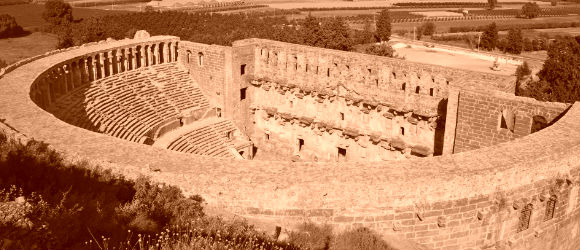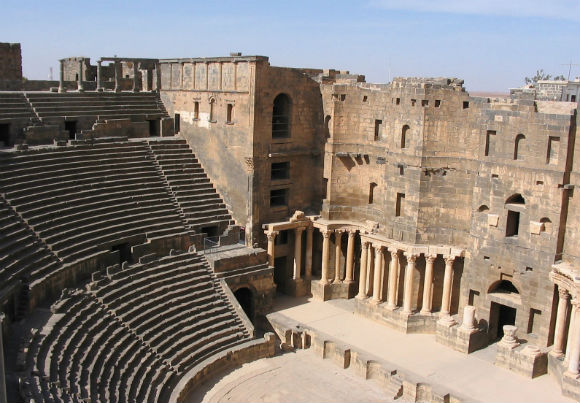Aspendos was an ancient Greco-Roman city in Antalya province of Turkey. It is located 7 kilometres (4.3 mi) northeast of central Serik.
Aspendos was an ancient city in Pamphylia, Asia Minor, located about 40 km east of the modern city of Antalya, Turkey. It was situated on the Eurymedon River about 16 km inland from the Mediterranean Sea; it shared a border with, and was hostile to, Side. According to later tradition, the (originally non-Greek) city was founded around 1000 BC by Greeks who may have come from Argos. The wide range of its coinage throughout the ancient world indicates that, in the 5th century BC, Aspendos had become the most important city in Pamphylia. At that time the Eurymedon River was navigable as far as Aspendos, and the city derived great wealth from a trade in salt, oil, and wool.
Aspendos did not play an important role in antiquity as a political force. Its political history during the colonization period corresponded to the currents of the Pamphylian region. Within this trend, after the colonial period, it remained for a time under Lycian hegemony. In 546 B.C. it came under Persian domination. The face that the city continued to mint coins in its own name, however, indicates that it had a great deal of freedom even under the Persians.
In 467 B.C. the statesman and military commander Cimon, and his fleet of 200 ships, destroyed the Persian navy based at the mouth of the river Eurymedon in a surprise attack. In order to crush to Persian land forces, he tricked the Persians by sending his best fighters to shore wearing the garments of the hostages he had seized earlier. When they saw these men, the Persians thought that they were compatriots freed by the enemy and arranged festivities in celebration. Taking advantage of this, Cimon landed and annihilated the Persians. Aspendos then became a member of the Attic-Delos Maritime league.
The Persians captured the city again in 411 B.C. and used it as a base. In 389 B.C. the commander of Athens, in an effort to regain some of the prestige that city had lost in the Peloponnesian Wars, anchored off the coast of Aspendos in an effort to secure its surrender. Hoping to avoid a new war, the people of Aspendos collected money among themselves and gave it to the commander, entreating him to retreat without causing any damage. Even though he took the money, he had his men trample all the crops in the fields. Enraged, the Aspendians stabbed and killed the Athenian commander in his tent.
When Alexander the Great marched into Aspendos in 333 B.C. after capturing Perge, the citizens sent envoys to him to request that he would not establish that he be given the taxes and horses that they had formerly paid as tribute to the Persian king. After reaching this agreement. Alexander went to Side, leaving a garrison there on the city’s surrender. Going back through Sillyon, he learned that the Aspendians had failed to ratify the agreement their envoys had proposed and were preparing to defend themselves. Alexander marched to the city immediately. When they saw Alexander returning with his troops, the Aspendians, who had retreated to their acropolis, again sent envoys to sue for peace. This time, however, they had to agree to very harsh terms; a Macedonian garrison would remain in the city and 100 gold talents as well as 4.000 horses would be given in tax annually.
In 190 BC the city surrendered to the Romans, who later pillaged it of its artistic treasures. Toward the end of the Roman period the city began a decline that continued throughout Byzantine times.
Aspendos,



Dont miss this if you are in the area. With temperatures around 40+degrees, was rather like being in a furnace, but didn't stop us enjoying this amazing site. Must be fantastic to watch opera here as they put on shows now and again. Watch out for the friendly gladiators! Nice little cafe to get a cold drink, not too dear.
This is a great site, worth stoping at if you travel round Antalya. The theater is very well preserved and you can really get the idea of how such places looked like in the Ancient times.
This is the kind of place you don't want to miss. This Roman amphitheatre is really well preserved. I would suggest to hire a guide so don't miss the interesting history of the place.
The theatre in Aspendos is breathtaking! Unfortunately the wonderful facade was all cover up for restoration so we could only see it in the brochure, but inside is such a wonderful place. You go back thousands of years and I personally do not know how much has been restored but doesn't really matter as it is really outstanding. Next time…
It was pouring with rain when we visited but we still found it inspiring – it is an awesome structure, and so well preserved! Due to the rain, it was not very busy and this allowed us to take some wonderful pictures and videos of the theater without many people in them! Definitely worth a visit.
I have visited Aspendos Theatre for an opera evening out as well as during the day when İ had to pay to get in – both wonderful experiences and well worth the visit –
Of all of the theaters I visited in Turkey and Greece, this was possibly the best. It was definitely the biggest. If you are in the area, this is definitely a place to visit. It is fairly well intact and gives you a decent idea of what it was like to be in a Greek theater. The only problem is…
One of the best preserved theatres I have ever seen. Two people sang and the whole of the crowd listened in silence – magic.
I will admit that this is a great preserved theatre however it's ot that big, waiking up the hill to see the other roman bits and prices was extremely disappointing and the walk down dangerous on the very poorly maintained paths. In Rome you would see this much in your first 10mins.
Good example of a Roman amphitheatre. Worth a visit. Better with a guide to give information. Roman soldiers add to the atmosphere, but they only want you to pay for a photo with them!